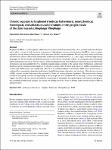Item Infomation
Full metadata record
| DC Field | Value | Language |
|---|---|---|
| dc.contributor.author | Elkader, Heba-Tallah Abd Elrahim Abd | - |
| dc.contributor.author | Al-Shami, Ahmed S. | - |
| dc.date.accessioned | 2023-10-02T08:21:00Z | - |
| dc.date.available | 2023-10-02T08:21:00Z | - |
| dc.date.issued | 2023 | - |
| dc.identifier.uri | https://link.springer.com/article/10.1007/s11356-023-29853-3 | - |
| dc.identifier.uri | https://dlib.phenikaa-uni.edu.vn/handle/PNK/9400 | - |
| dc.description | CC-BY | vi |
| dc.description.abstract | Bisphenol A (BPA), a common plastic additive, has been demonstrated mechanistically to be a potential endocrine disruptor and to affect a variety of body functions in organisms. Although previous research has shown that BPA is toxic to aquatic organisms, the mechanism of neurotoxic effects in marine bivalves remains unknown. The current study aimed to elucidate the neurotoxic effects of BPA when administered at different concentrations (0.25, 1, 2, and 5 µg/L) for twenty-eight days in the ganglia of a bivalve model, the Mediterranean mussel (Lithophaga lithophaga), which is an ecologically and economically important human food source of bivalve species in the Mediterranean Sea. | vi |
| dc.language.iso | en | vi |
| dc.publisher | Springer | vi |
| dc.subject | BPA | vi |
| dc.subject | Chronic exposure | vi |
| dc.title | Chronic exposure to bisphenol A induces behavioural, neurochemical, histological, and ultrastructural alterations in the ganglia tissue of the date mussels Lithophaga lithophaga | vi |
| dc.type | Book | vi |
| Appears in Collections | ||
| OER - Khoa học môi trường | ||
Files in This Item:

